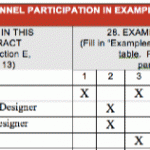
What happens when you ignore page limits?
As Matt DeVries utterly compelling article explains, maybe you win the contract. Then maybe your state’s Supreme Court upholds that award.
You should read the article at Best Practices Construction Law, which included this description of the situation:
“The Facts. In November 2010, the State issued a request for proposals to perform exterior renovations to the Governor’s House in Juneau. The request imposed specific submission requirements and guidelines. Paragraph 8 of the request included the instructions relevant to this appeal, which provided in part:
The maximum number of attached pages (each printed side equals one page) for criteria Responses shall not exceed: 10 pages.
Paragraph 8 warned that “Criteria Responses which exceed the maximum page limit or otherwise do not meet requirements stated herein, may result in disqualification.”
One contractor submitted a 7-page proposal; Silver Bow submitted a 10-page proposal; another contractor submitted an 11-page proposal; and Alaska Commercial Contractors (the awardee) submitted a 15-page proposal.
The Protest. Silver Bow protested the bid and argued that the over-length bid by Alaska Commercial was non-responsive and that the successful bidder should have been disqualified. The State countered that the page count was a matter of form and did not confer an advantage on the winning bidder.”
This Is Where It Gets Interesting
The court’s decision is actually quite logical. They basically concluded the winning proposal actually had less words than what was submitted by the protester. Therefore, the extra pages did not provide an advantage.
“The procurement officer for the Division accepted and reviewed all four proposals. The procurement officer concluded that Alaska Commercial’s proposal did not contain more substance than the others, that it was not in the State’s best interest to “needlessly reduce competition” by disqualifying acceptable proposals “strictly on form,” and that all four proposals had technical deficiencies. When the Division subsequently performed a word count, it found that Silver Bow’s proposal had 6,226 words, while Alaska Commercial’s proposal had 5,773 words”
See more at: http://caselaw.findlaw.com/ak-supreme-court/1673876.html#sthash.0zoHs4pg.dpuf
That’s very interesting, right?!?
What Are The Implications Of Something Like This?
First off, let’s think about this. Assuming that Alaska Commercial’s proposal had one inch margins, their text would have to average 13-14pt in size to only get 385 words on a page. Right off that bat, that’s odd.
Then there is this. Nobody in their right mind would submit a 15-page proposal when the RFP limited it to 10. That is, unless they knew it wouldn’t be rejected. Note that two of the four firms who submitted broke the page limit.
Also, remember that paragraph 8 said, “Criteria Responses which exceed the maximum page limit or otherwise do not meet requirements stated herein, may result in disqualification.” Of course, that’s very wishy washy. That gives the agency an out. But think about it. Many agencies use that same language. Yet, we adhere to page limits…at least I do.
At the very least, I think this ruling puts every firm that will submit a proposal to this agency in a weird situation. Has this agency set some sort of precedent that they’ll have to behave consistently with?
I’d like you to engage in a thought experiment with me. Let’s say you are submitting a proposal with a 10-page limit to this agency, what would you do? Would you adhere to the page limits?
Post your answers in the comments.





I am regularly faced with having to edit and structure page-limited proposals on behalf of clients – and yes, I would always respect and abide by the limit. However, meeting that limit may not be a case of having to write less, if they are over, but of clever formatting, font choices, and page layout. A recent proposal had a page limit and a font-size restriction – had to be 11 point font. The clients default font was Verdana, which is massive in 11pt. So I used Corbel, which is much smaller. Narrower margins and dual column layouts also conserve space. Never let a page limit get in the way of saying what you need to say!
Horrific. I regard page counts as sacrosanct. I will use devious tricks to pack more information in on behalf of my client, admittedly, but I’d always obey the letter of the law.
Reading between the lines, it sounds like the winner put in a lot of graphics and argued that the 10 page limit applied to the text. A risky strategy.
The example RFP says that submittals that do not meet requirements stated herein “may result in disqualification.” I think the important word here is “may.” The RFP doesn’t say that overly long proposals WILL result in disqualification; only that they MAY have that result. Clients use page limits because they don’t want to read too much. But it often turns out a firm/team cannot make a complete response while staying within the stipulated length. If the RFP says “WILL result…” I would probably stay within the limitation. Since the RFQ used the word “MAY,” I wouldn’t go much beyond the stated limit, but I wouldn’t be afraid to exceed it by a few pages. However, I would state in my cover letter that we have exceeded the page limit, but have kept our response as brief as we could while still responding completely to the RFP. It’s also a subtle way of telling the client that their page limit was too restrictive for the information they requested.
By the way, when the page limit is too restrictive, I would consider the possibility that the project is already wired for a firm the client knows, a firm that could write more briefly because the client already knows a lot about them. In that case, I might “No Go” instead.
Matt, unless I knew we had the “in” I’d stop at 10 pages. Although they said “may,” anything over just makes it too easy for them to reject and use that as the excuse.
An amazing story and court case!
I would do my best to meet it the page limit but would absolutely not bother to spend any amount of additional time word smithing and format fiddling with relevant text / graphics to get to the golden number.
I would absolutely limit my response to 10 pages and whatever else they prescribe. Why give them an option to disqualify you right off the bat? Write succinctly and well. Make every word earn it’s place. And DON’T use a tiny font the no one wants to read or omit white space and graphics. Speak in Benefits not Features.
I’d absolutely adhere to the page limit regardless of previous situations. Following solicitation instructions is one of the simplest and first ways that I can convey the work quality of my firm.
This is disheartening news to me. However, I am unfortunately noting that government, state and municipal bodies are bending rules more frequently to support particular agendas. It is nothing short of unnerving that the deciding court did a word count. Sorry, that just reeks of impropriety and of getting around the rules to support backroom bias. This governing body did little to support the consistency that is the backbone of the government proposal process. That is why forms such as the SF330 exist – in order to level the playing field.
Would I still observe page limits in this situation? Well, let me back out a little bit. I once made it all the way through the selection process, only to have a government agency do something illegal late in the game that disqualified us. (Only I did not know it was illegal at the time or that we could have protested.)
But here’s my takeaway: we did not propose to that agency again. If I know that an agency is not going to consistently and transparently do business, they are off my map. But sadly, many start-up contractors don’t have that choice.
I am still going to observe page limits if they are stated, in good faith that the proposee is not corrupt. However, the implications in this story are tremendous, making us/our government appear on a downhill slide. Will we someday have to submit our kickback monies along with our proposals? I hope not.
1) Alaska state Supreme Court is not legal guidance in other states. Alaska isn’t even on the radar when it comes to other states using this case as legal precedence. In other words, don’t try this at home. 2) The plaintiff was so far behind in the points awarded, the court was agreeing to save everyone time by siding with the agency. They counted words to create a way for the agency to weasel out of more delay. 3) The agency will have a really tough time in future with protests. IMHO this will mean every award will be protested and often go to trial, adding immeasurable delay and expense to every award. I would avoid spending time and money on writing proposals to this agency to avoid their self-inflicted problems. 4) In retrospect, the agency should have cancelled the procurement for lack of suitable responses (none of the responsive proposals scored high enough to be acceptable) and reissued the RFP. Now, they have a big problem with all future procurements.
Definitely. You never want to give the competition a reason to have your bid thrown out in case of a win.
Of course I would adhere to the page limits! Why risk being disqualified over something like that?
Mind blown– exceed the page limit!!
Thank you for sharing this story. If you know the client, you know what criteria matters more than others and “wishy washy” language is your friend in court.
I will always stick with the page limit, because as many above have said, why give them a reason to throw you out without even reading what you have said. I know of at least one public agency here in LA that has admin staff review submittals for their adherence to RFQ requirements–early in my career, one of my proposals was thrown out as non-responsive because I included that information in the resume intro text, and the reviewer wasn’t even reading the text, just scanning the document and checking boxes.
But, I also agree with Bernie’s comment. Whenever there is a requirement that seems overly limiting like this one, I counsel my firm to really consider what they know about the client, because it screams of a wired project. And the wishy washy text in the RFP basically allows the agency to choose whatever firm they really want, and “make up” the reasons afterwards.
Yes, I always adhere to the RFQ/P requirements in regard to page limit, font size etc…but I’ve seen this happen before, when I’ve asked for a debrief and had the opportunity to review the submitted proposals finding that many firms didn’t follow the instructions and yet made the shortlist and/or won the project. I think it happens more often than we realized. However, I would never be the one to take that chance.
I would stay with the requirements stated. Several years ago a big team put out a RFP response. We followed all the guidelines. Both the Principal and I counted our number of packages three times over and sealed the package. Unfortunately we were not short listed. The public agency informed us that we did not have the proper number of books. So I agree follow the requirements for you own protection.
Absolutely the wrong decision by the court. Number of words is irrelevant, it is the content, the impact of those words. Let’s assume the winner did NOT have an inside/inside information on length. If the winner had been forced to stay to 10 pages, they may very well have removed some content that was important in conveying their winning message. Analogously, if any of the losing firms had been allowed to go to 15 pages, they may very well have added more/different information that would have made their proposal better, and stand out more.
Further, counting words and finding fewer means that something else was taking up that space. And it’s entirely possible that something else tipped the decision in their favor.
Know your clients. Know their requirements. Choose your words wisely. Having done just this type of work for an engineering firm for over 15 years now, I have seen many versions of this. The case discussed here is interesting and many of us have a similar “for instance” to tell others. I will say have talked to a few clients over the years and here is what I learned in addition to the initial advise offered. When in doubt ask. You can always ask the question about how strict a limit or requirement is. For a large urban public client who will get 50 or 100 responses, I have been told that the restriction is firm which makes sense given the task of reviewing that many submissions. In this case, there is someone at the door with a checklist of requirements ( checking # of pages, # of copies, that all the myriad forms and certificates are present, etc.) who will cull your submission out on a technicality before anyone reads it. However, other clients may reply that this is the suggested length but for you to be as concise as possible. They are saying we want to hear what you have to say but be clear and concise and don’t overwhelm us. We all do what we need to in order to put our company’s best foot forward but remember that the underlying purpose is to give our clients solutions, value and benefits. Keep honing your message and don’t forget that clients are people too so get to know them before your ever send a proposal.
First, we can all agree that the reason for page limits is to reduce the amount of text firms want to cram in. Having been the person responsible for putting the responses together, I cannot tell you how many times the technical staff, PM’s or Principals want to include everything under the sun thinking that the client will think it is important – and that they will read it! Clients want you to cut through the weeds, get to the point and show what is truly relevant to their project. They don’t care about the rest. I personally enjoy page limits for that reason. Your project approach, benefits and message have to be clear and concise plus you save a lot of extra effort on both your marketing staff and the reader by not publishing a book, and it forces the team to really think about the client not themselves and all of their wonderful accomplishments.
That being said, try to stick to your page limits as you don’t want to give anyone a reason to disqualify you, however, if you know the client well enough, and they prefer to work with firms who think outside the box, then find a creative way to convey your information in a different way (infographics, personal proposal website, etc.). Showing how you work might just win you the project but it is a risky move to make so don’t try this with someone you have never contacted prior to your submittal.
As a practical matter, I always look to undershoot the page limit. Simpler and shorter is almost always better. If the opportunity isn’t wired up it’s a good way to convey approach and attitude to a client worth working with.
I recently worked on a Texas Department of Transportation proposal. The RFQ consisted of five forms. Each form contained one question. Each question had a limit on the number of CHARACTERS allowed. Once you input that many characters, the form simply wouldn’t accept any more. The problem, however, is that no matter how little time the agency wants to spend reading responses, sometimes they ask for more information than can reasonably be provided within the page or character limitation. This is sometimes a strong indication that the project is already wired for another firm, who won’t have to tell their whole story within the limitations because the agency already knows them very well. So these kinds of limitations should be considered as part of your Go/No Go evaluation.
Bernie,
One day I’ll have to tell you my TXDOT story. They are known for being very particular. Thank you for the comment. 🙂
Matt
I’ll suggest we re-evaluate the problem. We often get too focused on telling when selling. If we can just put MORE in, we’ll have an advantage. Rather than play games with font size, margins, or number of pages – show the client the complete solution to their problem in half the number of pages allowed. (While using easy to read fonts and plenty of white space.) As a buyer, that’s not only EASIER to read (and procure), but suggests you will be efficient in the rest of the delivery. If you can’t solve the problem within budget during the selection process – how likely are you to do that after award?
Selling is much less about telling what you will do for them, but demonstrating what you can do for them. Clear, concise, efficient communication could be your biggest differentiator.
“I would have submitted a shorter proposal, but I didn’t have time.” – Mark Twain (or, something like that).
Court case or not, deviating from the RFP requirements puts all of the effort positioning for the project at risk. If there’s one thing to do when responding to a RFP, it’s to be compliant. Lots of clients put in RFP language that gives them the flexibility to accept or reject just about any proposal. But why give them a reason to reject? If you get that concerned over saying what you need to within a page limit, ask a question on what counts towards it/doesn’t or if can you expand certain sections. And if you’re on the losing side pointing out a flaw in the procurement process, be cautious about how far you want to take that and what it may do to your client relationships. Dragging a client to court may not be the best way to get future work from them.
Recently a salesperson and I were reviewing our win-rate over the last ten years we’ve worked together. Ironically (or not) we are more successful at bids WITH page limits. Perhaps this is because page limits force the writer to weed out “marketing fluff” and say what needs to be said, clearly & concisely.
This: “Requirement B-3. Text shall not exceed 55 lines per page and page numbers shall be specified. Margins at the top, both sides, and bottom of each page shall be no less than 1 inch if formatted for 8.5 x 11 inch paper; no less than 2.5 cm at the top and both sides, and 4 cm at the bottom if formatted for A4 paper. Single-column or double-column formats are acceptable for text pages. Type fonts for text and figure captions shall be no smaller than 12-point (i.e., no more than 15 characters per inch; six characters per centimeter). There is no minimum requirement for fonts used within figures and tables, but all text in figures and tables shall be legible; fonts smaller than 8-point are often illegible.”
Since no one else has said what I have seen is the case in almost all of the fed responses I reply to…
The page limit restriction typically says any pages over the limit will be disregarded. It does not say that you will/may be disqualified. As a result, going over isn’t that big a risk. I generally don’t share this information with the folks writing because as stated by many it’s good for them to believe there is a limitation. And, it’s good to be succinct and clear to the evaluators.
Great reasoning. However, in procurement, ITB are like the guidelines which must be adhered to. Suppose the procuring entity requiring an emergency replacement had specified a font name, font size and page limit in the instruction with MAY led to disqualification clause and it turn out that most responsive bidders exceed or ignore the instruction. Suppose only one meets these guidelines but whose proposal is far inferior, who is then lowly ranked and moves to legally challenge the award, what option do the procuring entity have? Who bear the cost of losses due to delayed repairs and legal charges? What option due the winning bidder have?
Wow! I’m not sure many companies would take it to court but kudos to them for fighting it out. I always stick to the page requirements. If simple instructions like that can’t be adhered to, it sends a message that a firm doesn’t listen to their clients, begging the question “what else will they disregard.”
Huge airport contract. Teamed with a national firm as prime. 30 page limit. Got my copy via FedEx same time as City got prime’s submission. 35 pages. Client was a friend so paged him out of a meeting. He said, “I could overlook 1 or 2, but 5 pages is too many” He left our submission at reception and we sped over to tear out 5 pages before the deadline. Prime said, “we didn’t think they meant it”. It depends on the main evaluator and you can usually find out off record how strict they will be. PS We won the job.
Even with the “may” language, I’d stick to the 10-page limit unless (a) I knew my customer (including the procurement people) well enough to know that the limit was not an issue, and (b) it was literally impossible to win the bid unless the proposal had more than 10 pages.